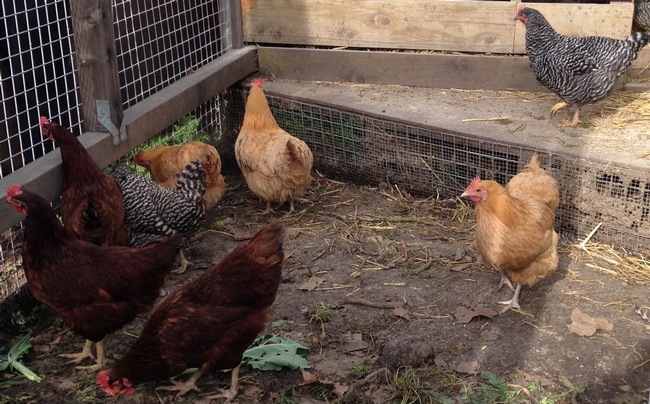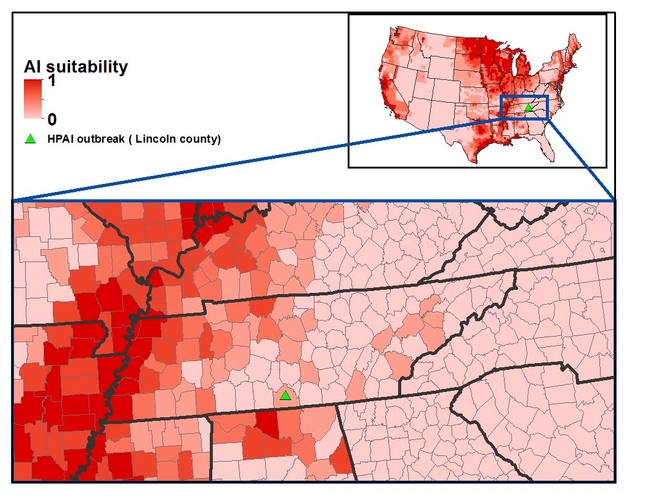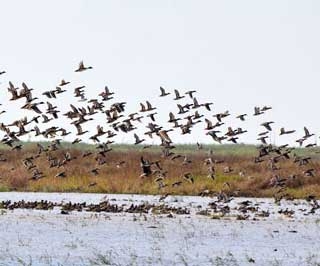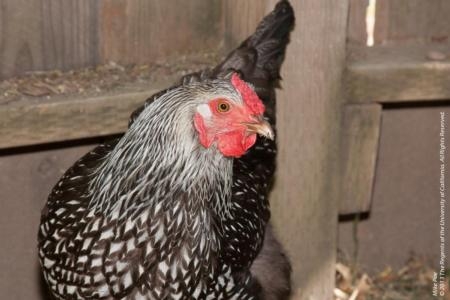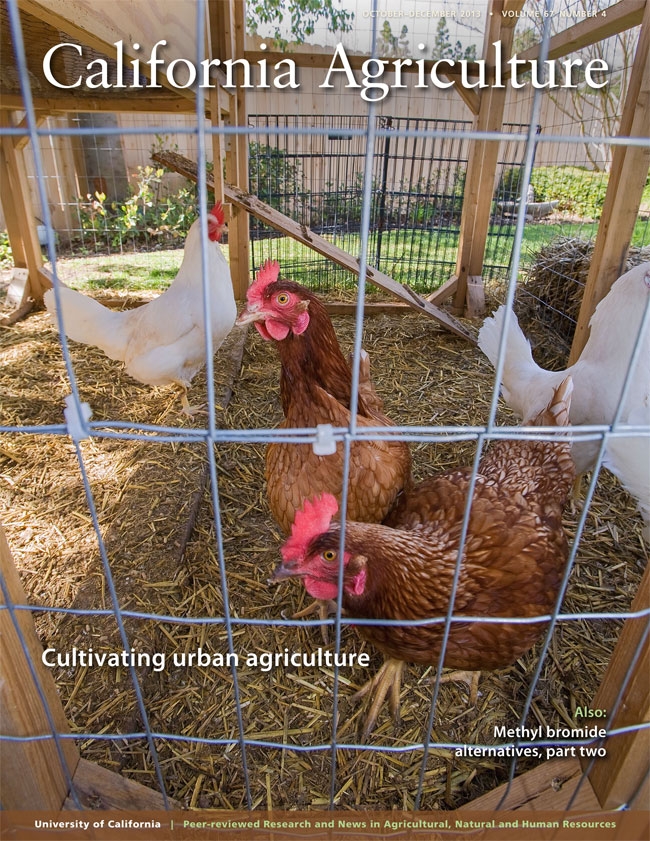Posts Tagged: biosecurity
Protect your poultry from avian flu
University of California poultry experts are urging poultry owners to examine biosecurity for their flocks after avian influenza was confirmed in commercial chickens in Tennessee by the USDA Animal and Plant Health Inspection Service on Sunday (March 5). To protect the birds' health, UC scientists recommend taking measures to prevent poultry from coming into contact with wild birds.
"Based on the initial sequence of the virus, the source of the virus is thought to be waterfowl, said Maurice Pitesky, UC Cooperative Extension poultry specialist in the School of Veterinary Medicine at UC Davis. “This is consistent with the current understanding of how avian influenza spreads and evolves. Specifically, juveniles are infected at breeding locations and travel south in the fall carrying virus. As the waterfowl move southward, they are more likely to interact with other species, increasing the risk of interspecies transmission and formation of new varieties of avian influenza.”
The case in Lincoln County, Tenn., is the first report of highly pathogenic H7 avian influenza in commercial poultry in the United States this year. The flock of 73,500 affected chickens is located within the Mississippi Flyway, one of four North American flyways for migratory birds.
“Lincoln County is located in one of the medium-high risk areas that were identified by our risk map, said Beatriz Martínez López, director of the Center for Animal Disease Modeling and Surveillance in the School of Veterinary Medicine at UC Davis.
“We need to increase awareness of poultry producers to maximize the biosecurity implemented in their operations, particularly in those located in high risk areas, mainly farms that are in close proximity to wetlands or other wild bird feeding and resting areas,” said Martínez López.
Poultry owners can identify biosecurity strengths and weaknesses for their own farm or backyard flock by filling out a free survey designed by Martínez López and other poultry experts. People who raise chickens, quail, ducks, turkeys, geese or other birds anywhere in the United States are invited to use the resource. At the end of the survey, participants receive specific research-based recommendations of biosecurity measures they can apply on their own types of farms. The poultry biosecurity survey is available in English http://bit.ly/2kkMycf and Spanish http://bit.ly/2mjO13G. The survey takes 15 to 20 minutes to complete and will be open until June 1.
If you would like UC Cooperative Extension to notify you if there is an avian influenza outbreak in your area, sign up on the California Poultry Census page: http://ucanr.edu/sites/poultry/California_Poultry_Census.
Owners of backyard chickens who observe illness or increased mortality among their birds should call their veterinarian or the California Department of Food Agriculture sick bird hotline at (866) 922-BIRD (2473).
For more information about raising poultry, visit http://ucanr.edu/sites/poultry.
California chickens at increased risk for severe 'bird flu' strain
UC Davis poultry experts are urging backyard chicken enthusiasts and commercial poultry owners to practice strong biosecurity measures to prevent contact with wild birds, due to highly pathogenic strains of avian influenza recently detected in migratory waterfowl in British Columbia, Washington, Oregon, and Butte County, California.
The current detected strains, H5N2 and H5N8, are not a risk to human health and have not been found in commercial poultry in the United States. However, commercial poultry flocks in British Columbia and backyard flocks in Washington and Oregon have been affected.
Avian influenza -- commonly called "bird flu" -- is a disease found in a wide variety of domesticated and wild birds. Once introduced into an area, infection can spread through bird-to-bird contact or through contact with contaminated clothing, shoes, hands, feed, water or equipment. Because waterfowl are reservoirs for avian influenza strains that can be fatal to domestic poultry (yet often show little to no signs in waterfowl), backyard and commercial chickens raised near areas commonly used by migrating waterfowl are at risk of transmission.
"Due to normal waterfowl migration along the Pacific Flyway, during the winter there are approximately eight times the number of waterfowl in California than what we will see three months from now," said Maurice Pitesky, a UC Cooperative Extension specialist with the UC Davis School of Veterinary Medicine. "There are lots of birds that winter and establish roosting and feeding habitat in California wetlands and agricultural crops. If you are a poultry owner -- either backyard or commercial -- and live in proximity to waterfowl and their habitat, your birds are at risk."
Owners of backyard chickens who observe illness or increased mortality in their birds should call their veterinarian or the California Department of Food Agriculture sick bird hotline at (866) 922-2473.
The California Animal Health and Food Safety Laboratory System includes four diagnostic labs in Davis, Turlock, Tulare and San Bernardino. The labs encourage veterinarians and owners of backyard chickens to submit sick or recently dead birds for necropsy (postmortem) examination. The exam is free of charge for California backyard flock owners of fewer than 1,000 birds (chicken, turkey, waterfowl and squabs). For more information, contact (530) 752-8700 or visit: <http://www.vetmed.ucdavis.edu/cahfs/>
Reduce the risk of bird flu
To reduce the risk of avian influenza transmission, chickens should be kept separate from wild birds and monitored for signs of illness or increased mortality. The CDFA also urges owners to take the following necessary and crucial precautions:
- If you have a pond or body of water that can attract waterfowl to or near your facility, consider draining if feasible.
- Provide housing to confine domestic poultry and/or enclose an exercise area with netting.
- Avoid use of water that comes from sources where waterfowl may congregate during migration.
- Ideally, owners of poultry should try to avoid waterfowl hunting during migration. Otherwise, ensure clothing, footwear, vehicles, etc. used during hunts are laundered and/or disinfected.
- Permit only essential workers and vehicles on premises and provide disposable coveralls, boots and head coverings for visitors.
- Clean and disinfect vehicles and equipment entering or leaving the premises.
- Control movement associated with the disposal of mortality, litter and manure.
Additional resources
Information on good biosecurity and hygiene precautions to keep backyard flocks healthy can be found at:
- UC Cooperative Extension: Backyard Poultry Resources: <http://ucanr.edu/sites/poultry/type/backyard>
- USDA Animal and Plant Health Inspection Service: <http://healthybirds.aphis.usda.gov>
- California Department of Food and Agriculture Avian Health Program: <http://www.cdfa.ca.gov/ahfss/Animal_Health/Avian_Health_Program.html>
Reports of dead, wild birds can be directed to the Wildlife Investigations Lab at (916) 358-2790. There is also a Web application for submission: http://bit.ly/17ESHWy.
The University of California Global Food Initiative aims to put the world on a path to sustainably and nutritiously feed itself. By building on existing efforts and creating new collaborations among UC's 10 campuses, affiliated national laboratories and the Division of Agriculture and Natural Resources, the initiative will develop and export solutions for food security, health and sustainability throughout California, the United States and the world.
Backyard chicken post-mortem service boosts biosecurity
Backyard chickens are booming in California, but many owners don't know how to protect their flock from infectious disease. To help keep diseases from imperiling amateur and ultimately commercial operations, the California Animal Health and Food Safety (CAHFS) laboratories offer a free — but underused — post-mortem service for backyard poultry. New research tracks trends in poultry submissions, analyzes major causes of death and calls for raising awareness of this service.
Called the CAHFS Backyard Flock program, this service is funded by the California Department of Food and Agriculture as a biosecurity measure.
"Urban chicken owners generally aren't trained to recognize to recognize signs of illness, there are few if any chicken vets in the city, and online forums are not moderated by experts," says CAHFS researcher Sarah Stinson, lead author of the article.
The study showed that Backyard Flock submissions rose nearly fourfold between 2007 and 2012. Chickens accounted for 91 percent of submissions, and the greatest increases were in Santa Clara, Los Angeles and Sonoma counties. Diagnoses revealed that the birds' digestive and hemolymphatic systems were most commonly affected, and that the most common illness was Marek's disease, a highly contagious virus that can kill up to 80 percent of infected birds.
However, only an estimated 2 percent of amateur poultry keepers are aware of and have used the Backyard Flock program. To decrease the biosecurity risk of infectious diseases in backyard poultry, the researchers recommend advertising this disease testing service as well as reliable information about keeping backyard flocks healthy. For example, backyard chicken websites and online forums could be invited to add links to government websites, programs and information.
Besides keeping their flocks disease-free, people should keep hens in coops that protect them from cats and other urban predators, and give them specially formulated chicken feed from feed stores rather than chicken scratch or scraps. Moreover, even where chickens are legal, it's a good idea to talk to the neighbors before setting up a coop. Ways to earn goodwill include keeping hens in the coop until neighbors are awake, sharing eggs and, most of all, forgoing roosters, which can crow loudly day and night.
Link to full article: Popular Backyard Flock program reduces biosecurity risks of amateur production
Also in this issue of California Agriculture journal:
Testing protocol ensures the authenticity of organic fertilizers
After major "organic" fertilizer suppliers were found using cheaper inorganic compounds, the state gave the California Department of Food and Agriculture the authority to verify organic fertilizers starting in 2010. But there has been no good way to test whether fertilizers are actually organic. Now, UC researchers have developed an inexpensive method for distinguishing organic from synthetic fertilizers. This method assesses N15, an isotope of nitrogen that is relatively high in organic sources; ammonium, which is relatively low in most organic sources; and the ratio of carbon to nitrogen, which has a characteristic value for a given organic source.
Soil type, crop and irrigation all influence optimal nitrogen management
Groundwater can be contaminated by nitrate, and most of this contamination comes from fertilizer applied to crops. It makes intuitive sense to address this problem by managing nitrogen on farms, and this is the approach recommended by the California State Water Resources Control Board. However, new research shows that nitrate levels in groundwater are also affected by soil type and rainfall, which cannot be managed, as well as by irrigation and crop type, which can. Rather than focusing solely on nitrogen management, the researchers call for best management practices that also include irrigation management and that can be tailored individually to farms.
These research articles and the entire October-December 2013 issue can be downloaded at: http://californiaagriculture.ucanr.edu.
California Agriculture is the University of California's peer-reviewed journal of research in agricultural, human and natural resources. For a free subscription, go to: http://californiaagriculture.ucanr.edu, or write to calag@ucanr.edu.
The University of California's Division of Agriculture and Natural Resources is the bridge between local issues and the power of UC research. UC ANR's advisors, specialists and faculty bring practical, science-based answers to Californians. Visit ucanr.edu to learn more.
WRITERS/EDITORS: To request a hard copy of the journal, e-mail crllopez@ucanr.edu

